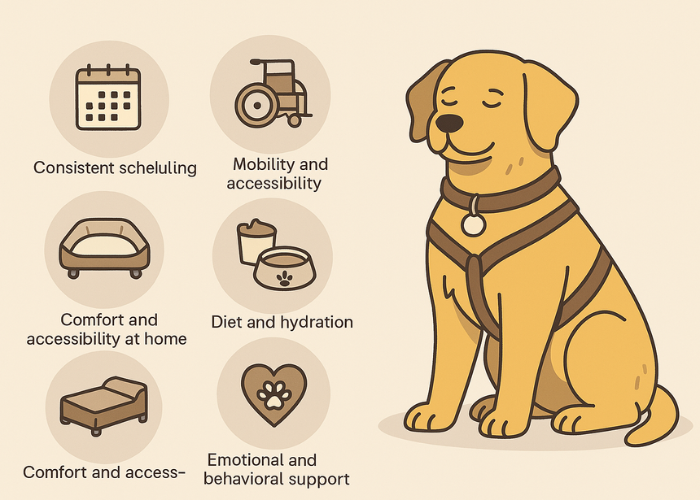Walking your dog is one of the simplest and most effective activities to improve both your physical and emotional health.
This routine not only strengthens the bond between you and your pet but also provides numerous health and quality-of-life benefits. In this article, we will explore the advantages of walking your dog and how to turn this activity into an enjoyable and healthy habit.
1. Physical Benefits for You and Your Dog
Walking is an excellent form of exercise for both the owner and the pet. Regular activity helps maintain an ideal weight, improves cardiovascular health, and strengthens muscles.
- Weight Control: Regular walks help prevent weight gain and obesity, which can lead to issues such as diabetes and joint pain.
- Heart Health: Walking reduces the risk of cardiovascular diseases and improves circulation in both humans and dogs.
- Energy and Vitality: Physical activity boosts energy levels and enhances mood, fighting a sedentary lifestyle.
2. Positive Impact on Mental Health
Beyond physical benefits, walking has a significant impact on mental health for both you and your dog. Time spent outdoors and exposure to nature promote well-being and reduce stress.
- Stress Reduction: Walking releases endorphins, which help combat stress and anxiety.
- Mental Stimulation: For dogs, walks provide an opportunity to explore new scents, sounds, and sights, keeping their minds active and curious.
- Strengthening the Bond: Quality time during walks reinforces the connection between you and your pet.
3. Routine and Discipline
Establishing a habit of daily walks creates a healthy routine for both you and your dog. This consistency also contributes to your pet’s training.
- Prevention of Undesirable Behaviors: Regular walks help expend accumulated energy, reducing destructive behavior at home.
- Training in Practice: Walks provide an opportunity to reinforce commands such as “heel,” “sit,” and “stay,” improving your dog’s obedience.
- Commitment to Health: Setting a fixed schedule for walks instills discipline in both owner and pet.
4. How to Make Walks More Effective
To maximize the benefits of walking, a few simple precautions can make all the difference. Here are some tips to ensure a safe and enjoyable experience:
- Choosing the Right Equipment: Use a collar and leash suited to your dog’s size and personality to ensure safety and comfort.
- Hydration: Carry water for both you and your pet, especially on hot days.
- Ideal Timing: Walk early in the morning or late in the afternoon to avoid excessive heat.
- Varied Terrain: Alternate between grass, dirt, and asphalt surfaces to stimulate your dog’s senses.
5. Walks as a Form of Socialization
Walks provide excellent opportunities for your dog to socialize with other animals and people. Proper socialization is essential for raising a balanced and confident pet.
- Positive Interactions: Allow your dog to meet other animals and people in a controlled and positive way.
- Different Environments: Explore parks, plazas, and other locations where your dog can experience new situations.
- Avoid Overwhelming Situations: Monitor your dog’s signals to ensure they are not feeling overstimulated or stressed.
6. Walking Dogs of Different Ages and Breeds
Each dog has unique needs, and walks should be adapted based on age, size, and energy levels.
- Puppies: Short and frequent walks are ideal as puppies develop muscle strength and endurance.
- Adults: Adult dogs can walk for longer periods, depending on breed and fitness level.
- Seniors: Older dogs need gentle walks with breaks to prevent excessive strain.
- Specific Breeds: Brachycephalic breeds (e.g., Pugs, Bulldogs) require extra care due to breathing difficulties, while high-energy breeds (e.g., Border Collies, Huskies) need more exercise.
Conclusion
Walking your dog is a simple yet powerful activity that provides significant physical and mental health benefits for both of you. Besides strengthening the bond between owner and pet, walks contribute to a more active and balanced life.
By incorporating this habit into your daily routine, you invest in your well-being and your dog’s. Every walk is an opportunity to create memories, improve health, and reinforce your connection with your pet. Whether long or short, the quality of time spent together matters most.
Consistency is key. Make daily walks a habit and enjoy the many benefits this practice offers. Your dog will be healthier and happier, and you will also experience improvements in your overall quality of life.
Frequently Asked Questions
What is the ideal duration for a dog walk?
The ideal duration varies based on your dog’s age, size, and health. Generally, 30 minutes to 1 hour per day is sufficient for most dogs.
Can I walk my dog at any time of the day?
Avoid peak heat hours to prevent paw burns and overheating. Morning and late afternoon are the best times.
What should I do if my dog refuses to walk?
Check for discomfort, such as pain or fatigue. Use treats for encouragement and choose shorter, more enjoyable routes.
Do senior dogs need daily walks?
Yes, but walks should be adapted to their physical condition. Light strolls help maintain mobility and overall health.
How do I know if my dog is tired during a walk?
Signs like heavy panting, slowing down, or frequent lying down indicate it’s time to take a break or end the walk.



